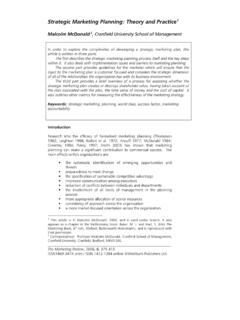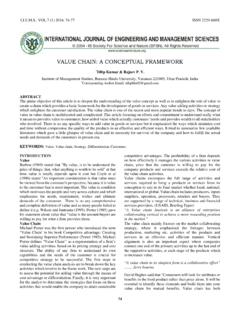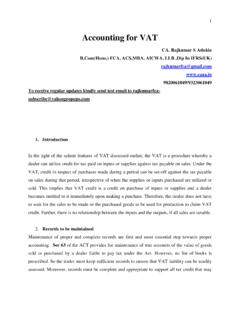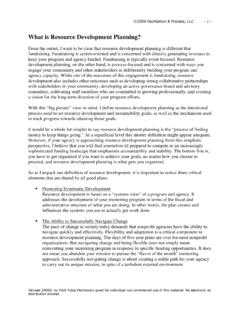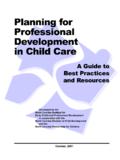Transcription of INTRODUCTION TO PROJECT PLANNING AND …
1 INTRODUCTION TO PROJECT PLANNING AND development Learning Objectives After completing the training, participants will: 1. Have an overview of the PROJECT PLANNING and development process. 2. Complete activities that incorporate the 11 steps of PROJECT development . The PROJECT Cycle The process of PLANNING and managing projects follows a logical, continuous cycle. Each phase of the PROJECT leads to the next. The identify stage includes a needs assessment process to determine the needs and problems in a community. The design phase includes the actual PLANNING and design of a PROJECT .
2 The implement stage refers to the implementation of the PROJECT , whether it is a single-year or multi-year implementation period. The evaluation of PROJECT results occurs at the end of a PROJECT and involves determining whether the PROJECT s goal and objectives were achieved. The evaluation stage then leads to the identification of additional or persisting problems, allowing the cycle to begin again. PROJECT monitoring occurs throughout all stages allowing for small adjustments in the PROJECT s PLANNING , design, and implementation in order to ensure the PROJECT s success.
3 An Overview of PROJECT PLANNING PROJECT PLANNING involves a series of steps that determine how to achieve a particular community or organizational goal or set of related goals. This goal can be identified in a community plan or a strategic plan. PROJECT plans can also be based on community goals or action strategies developed through community meetings and gatherings, tribal council or board meetings, or other PLANNING processes. The PLANNING process should occur before you write your application and submit it for funding.
4 PROJECT PLANNING : identifies specific community problems that stand in the way of meeting community goals. creates a work plan for addressing problems and attaining the goals. describes measurable beneficial impacts to the community that result from the PROJECT s implementation. determines the level of resources or funding necessary to implement the PROJECT . Why is PROJECT PLANNING important? PROJECT PLANNING helps us to: PROJECT PLANNING helps to eliminate: think ahead and prepare for the future clarify goals and develop a vision identify issues that will need to be addressed choose between options consider whether a PROJECT is possible make the best use of resources motivate staff and the community assign resources and responsibilities achieve the best results poor PLANNING overambitious projects unsustainable projects undefined problems unstructured PROJECT work plans Approach to Community development The community and its involvement are central to designing and implementing
5 A successful PROJECT . Many government and other funders seeks to fund community-based projects that reflect the cultural values, collective vision, long-range governance, and social and economic development goals of native communities. The following overview includes some key points to consider during the PROJECT - PLANNING phase. Local decision making in achieving community self-sufficiency is fundamental in the success and positive growth in every community. Community involvement is central to both the strategic PLANNING and PROJECT PLANNING that occurs before the development of any grant application.
6 However, in addition to a detailed description of community involvement in the PLANNING and implementation phases of the PROJECT , proposals must provide documentation to verify community involvement in and support for the proposed PROJECT . This documentation should explain and provide evidence of how the community was involved in determining problems faced by its members and in designing strategies for reducing or eliminating those problems. Keep in mind that each of the documentation sources listed below provides information about different elements of the PLANNING process.
7 Examples of documentation can include the following: summary of a community comprehensive plan summary of a community strategic plan summary of results from a community needs assessment Tribal Council or Board meeting minutes and/or sign-in sheets community meeting minutes and/or sign-in sheets community surveys There are different methods for involving your community in the PROJECT PLANNING process. Below are some examples: Comprehensive PLANNING This process involves completing a community-wide needs assessment to engage the community in identifying and prioritizing all long-range goals and the community problems preventing the achievement of those goals.
8 Next, the community is involved in the process of developing a method to accomplish long-range goals, also discussing initial ways to overcome the problems. This method should include a process to measure the progress towards achieving those goals. Comprehensive plans usually require at least a year to complete, and cover a five- to ten-year time span. Strategic PLANNING This is a process used when a community or organization already has a comprehensive plan and wants to move forward to achieve its long-range goals. Strategic PLANNING involves the participation of the community in identifying problems that stand between the community and its goals and moves the community toward realizing its long-range vision.
9 The product of strategic PLANNING , often simply called the strategic plan, builds on pre-established long-range goals by designing projects related to one or more of these goals. A strategic plan generally takes at least a year to complete. What if your organization does not have a comprehensive or strategic plan? Comprehensive and strategic PLANNING are time-consuming processes. They require the development of a community-wide needs assessment that collects community input and is then analyzed to prioritize problems and basic needs of the community.
10 If your organization does not have a comprehensive or strategic plan that documents long-range goals and problem areas or your specific situation does not warrant having either document, there are alternative ways of documenting community involvement. Alternative Methods of Documentation Minutes of past general council meetings or community meetings that document the community s perception of long-range goals and problems can be used to show that your PROJECT has a history of community PLANNING activities. This historical documentation of community problems and the PROJECT designed to address those problems should be supplemented through community assessments that determine current conditions and concerns.
